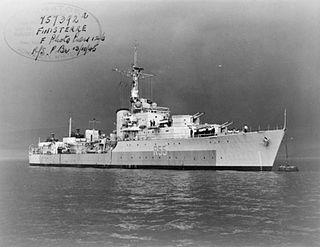
HMS Finisterre was a Battle-class destroyer of the Royal Navy (RN). She was named after one of the battles of Cape Finisterre. She was the first and thus far the only ship of the Royal Navy to bear this name.
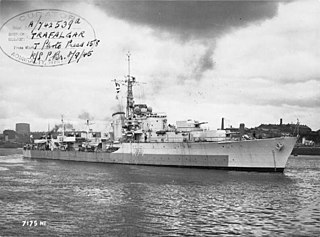
HMS Trafalgar was a Battle-class destroyer of the Royal Navy (RN). She was named after the Battle of Trafalgar, a decisive British victory over a Franco-Spanish Fleet in 1805. Trafalgar was built by Swan Hunter on the Tyne. She was launched on 12 January 1944 and commissioned on 23 July 1945.

HMS Camperdown was a Battle-class destroyer of the Royal Navy (RN). She was named after the Battle of Camperdown, a naval engagement between the British and Dutch that took place in 1797, and which resulted in a British victory.

HMS Barrosa (D68) was a later or 1943 Battle-class fleet destroyer of the Royal Navy.
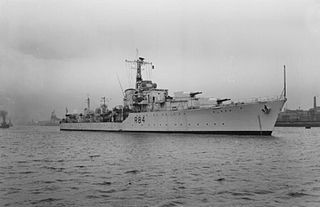
HMS Saintes was a 1942 Battle-class fleet destroyer of the Royal Navy (RN). She and 15 sister ships being ordered under the 1942 defence estimates. The ship was named after the Battle of the Saintes, a Royal Navy victory over a French fleet intending to invade Jamaica in 1782. So far she has been the only ship of the Royal Navy to bear the name. Saintes was built by Hawthorn Leslie and Company on the Tyne. The vessel was launched on 19 July 1944 and commissioned on 27 September 1946.

HMS Corunna (D97) was a later or 1943 Battle-class fleet destroyer of the Royal Navy. She was named in honour of the Battle of Corunna, which took place during the Peninsular War in 1809 between British and French forces. Corunna was built by Swan Hunter & Wigham Richardson Limited on the Tyne. She was launched on 29 May 1945 and commissioned on 6 June 1947.
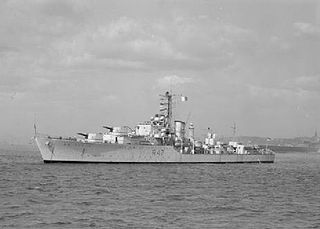
HMS Gabbard was a Battle-class destroyer of the Royal Navy (RN). She was named in honour of the Battle of the Gabbard, which occurred in 1653, and which resulted in an English victory over the Dutch Fleet. Gabbard was built by Swan Hunter & Wigham Richardson Limited on the Tyne. She was laid down on 2 February 1944, launched on 16 March 1945 and completed on 10 December 1946.

HMS Solebay was a Battle-class destroyer of the Royal Navy (RN). She was named after the Battle of Solebay which took place in 1672 between an Anglo-French force and the Dutch Navy during the Third Anglo-Dutch War. Solebay was built by R. & W. Hawthorn, Leslie & Company Limited on the Tyne. She was launched on 22 February 1944 and commissioned on 25 September 1945.

BAPFerré(DM-74) was a Daring-class destroyer in service with the Peruvian Navy from 1973 to 2007. She was built by Yarrow Shipbuilders and completed for the Royal Navy in 1953 as HMS Decoy (D106).

HMS Grenville was the second ship of this name to serve with the Royal Navy in the Second World War. Grenville and seven other U-class destroyers were ordered as part of the Emergency Programme. She was launched at Swan Hunter and Wigham Richardson Ltd., Wallsend-on-Tyne on 12 October 1942 and commissioned on 27 May 1943.

HMS Dainty was a Daring-class destroyer of the British Royal Navy. Ordered in 1945, she was built by J. Samuel White at their Isle of Wight shipyard, being launched in 1950 and completed in 1953.
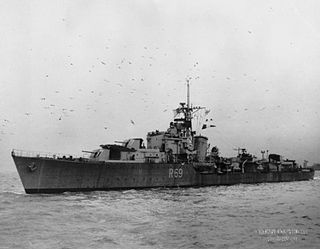
HMS Ulysses was a U-class destroyer of the British Royal Navy that saw service during World War II. She was later converted into a Type 15 fast anti-submarine frigate, with the new pennant number F17.

HMS Undine was a U-class destroyer of the British Royal Navy that saw service during World War II. On 27 March 1945, HMS Undine detached from RN Fast Carrier TF57 to rescue the airmen of a downed RN TBF Avenger aircraft also rescued a USN Corsair pilot adrift for two days south of the Sakishima Gunto in the Philippine Sea.

HMS Ursa was a U-class destroyer of the Royal Navy that saw service during the Second World War. She was later converted into a Type 15 fast anti-submarine frigate, with the new pennant number F200.

The second HMS Whirlwind was a W-class destroyer of the British Royal Navy and was built by Hawthorn Leslie and was launched on 30 August 1943. She saw service during World War II and the Cold War.

HMS Kempenfelt was a W-class destroyer flotilla leader of the Royal Navy that served in the Second World War. She was the second destroyer of her name to have served in the war; the first Kempenfelt was transferred to the Royal Canadian Navy in October 1939 and renamed HMCS Assiniboine.

HMS Carysfort was a C-class destroyer of the Royal Navy. She was ordered in 1941, originally under the name HMS Pique.
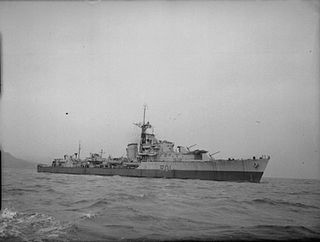
HMS Caprice was a C-class destroyer of the Royal Navy, ordered on 16 February 1942 from Yarrow, Scotstoun. She was originally to be named HMS Swallow but this was changed to Caprice before launch to fit her revised class name. She is the only British warship to have had this name. She was adopted by the Civil Community of Bexley and Welling, as part of the Warship Week programme.

HMS Zodiac was a Z-class destroyer of the Royal Navy built in 1944 by John I. Thornycroft, Woolston. She served during the Second World War, participating in operations in the North Sea and off the Norwegian coast, before taking part in some of the Arctic convoys. She spent a further ten years in Royal Navy service after the end of the war, before being sold to the Israeli Navy, which operated her as INS Yaffo. She saw action during the Suez Crisis in 1956, attacking Egyptian ships and was still active by the outbreak of the Six-Day War in 1967.

HMS Zambesi was a Z-class destroyer. She has been the only Royal Navy warship to bear that name. She was launched on 21 December 1942 at the Cammell Laird shipyard at Birkenhead and commissioned on 18 July 1944. She was 'adopted' by the civil community of Bromley, as part of Warship Week in 1942.




















